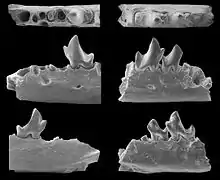Nyctitheriidae
Nyctitheriidae is a family of extinct eulipotyphlan insectivores known from the Paleocene and Eocene epochs of North America and Asia and persisting into the Oligocene of Europe. Several genera, including Nyctitherium, Paradoxonycteris, and Wyonycteris, have initially been described as bats, although the family is more frequently placed in the order Eulipotyphla.
| Nyctitheriidae | |
|---|---|
 | |
| SEM images of teeth and mandible fragments of Asionyctia guoi. From Missiaen and Smith, 2005. | |
| Scientific classification | |
| Kingdom: | |
| Phylum: | |
| Class: | |
| Order: | |
| Family: | |
| Subfamilies | |
| |
Origins and discovery
O.C. Marsh originally described Nyctitherium, from the Eocene of Wyoming, as an early bat based on similarities of its teeth.[1] Since 1872 more than two dozen other genera of nyctitheriids have been named, and several of these have also initially been considered bats.[2][3] G.G. Simpson recognized that Nyctitherium did not represent a bat, and in 1928 named the family Nyctitheriidae for Nyctitherium and several other small insectivores.[4]
Many additional species of Nyctitheriidae from Asia, Europe, and North America have been recognized in the subsequent decades. Most species are known only from isolated teeth and jaw fragments, however species of Cryptotopos, Euronyctia, Plagioctenodon, and Scraeva are known from some postcranial bones.[5][6]
Evolutionary relationships
A recent phylogenetic analysis placed Nyctitheriidae within Eulipotyphla,[5] although Hooker (2001, 2014) has argued based on similarities in the limb bones for a relationship with Euarchonta, instead.[7][6]
Lopatin (2006) recognized five subfamilies of Nyctitheriidae: Amphidozotheriinae, Asionyctiinae, Eosoricodontinae, Nyctitheriinae, and Praolestinae.[8] Beard and Dawson (2009) considered Placentidentinae, previously thought to be related to Dermoptera, to also represent a subfamily within Nyctitheriidae.[9] A phylogenetic analysis of many nyctitheriid species determined that although Nyctitheriidae was mostly monophyletic several subfamilies and genera were not. Notably, the subfamilies Amphidozotheriinae, Asionyctiinae, and Nyctitheriinae, as well as the genera Leptacodon and Saturninia, were found to be paraphyletic.[10]
References
- Marsh, O. C. (1872-09-01). "Preliminary description of new Tertiary mammals". American Journal of Science. s3-4 (21): 202–224. Bibcode:1872AmJS....4..202M. doi:10.2475/ajs.s3-4.21.202. ISSN 0002-9599.
- Revilliod, Pierre (1922). "Contribution à l'étude des Chiroptères des terrains tertiaires. Troisième partie et fin". Abhandlungen der schweizerischen palaeontologischen geologischen Gesellschaft. 45: 133–195.
- Gingerich, Philip D (1987). "Early Eocene bats (Mammalia, Chiroptera) and other vertebrates in freshwater limestones of the Willwood Formation, Clark's Fork Basin, Wyoming". University of Michigan Contributions from the Museum of Paleontology. 27: 275–320.
- Simpson, George Gaylord; Brown, Barnum; Siegfriedt, J. C. F. (1928). "A new mammalian fauna from the Fort Union of southern Montana. American Museum novitates ; no. 297". hdl:2246/3165. Cite journal requires
|journal=(help) - Manz, Carly L.; Chester, Stephen G. B.; Bloch, Jonathan I.; Silcox, Mary T.; Sargis, Eric J. (2015-01-31). "New partial skeletons of Palaeocene Nyctitheriidae and evaluation of proposed euarchontan affinities". Biology Letters. 11 (1): 20140911. doi:10.1098/rsbl.2014.0911. PMC 4321154. PMID 25589486.
- Hooker, Jerry J. (2014-12-14). "New postcranial bones of the extinct mammalian family Nyctitheriidae (Paleogene, UK): Primitive euarchontans with scansorial locomotion". Palaeontologia Electronica. 17 (3): 1–79. doi:10.26879/482. ISSN 1094-8074.
- Hooker, J. J. (2001-08-01). "Tarsals of the extinct insectivoran family Nyctitheriidae (Mammalia): evidence for archontan relationships". Zoological Journal of the Linnean Society. 132 (4): 501–529. doi:10.1111/j.1096-3642.2001.tb02473.x. ISSN 0024-4082.
- Lopatin, A. V. (2006-05-01). "Early Paleogene insectivore mammals of Asia and establishment of the major groups of Insectivora". Paleontological Journal. 40 (3): S205–S405. doi:10.1134/S0031030106090012. ISSN 1555-6174.
- Beard, K. Christopher; Dawson, Mary R. (November 2009). "Early Wasatchian Mammals of the Red Hot Local Fauna, Uppermost Tuscahoma Formation, Lauderdale County, Mississippi". Annals of Carnegie Museum. 78 (3): 193–243. doi:10.2992/007.078.0301. ISSN 0097-4463.
- Manz, Carly L.; Bloch, Jonathan I. (2015-09-01). "Systematics and Phylogeny of Paleocene-Eocene Nyctitheriidae (Mammalia, Eulipotyphla?) with Description of a new Species from the Late Paleocene of the Clarks Fork Basin, Wyoming, USA". Journal of Mammalian Evolution. 22 (3): 307–342. doi:10.1007/s10914-014-9284-3. ISSN 1573-7055.